Gentle reminder from Steve Jobs: Start with the Customer, Not the Technology.
In a candid exchange, Steve Jobs offered profound insights that remain timeless in their relevance.
Reflecting on his journey, Jobs articulated a philosophy that has arguably shaped the most successful products and companies: Start with the customer experience and work backward toward the technology.
Here are the core tenets from Jobs’ approach:
1. Customer-centric innovation: True innovation begins by envisioning the customer’s journey, their challenges, and aspirations—not the technology in a vacuum.
2. Reverse engineering success: The best products are born from the benefits they offer, not the features they boast.
3. Cohesive vision over isolated breakthroughs: Cohesion in vision ensures that individual innovations contribute to broader business goals, such as Apple’s market success.
4. Learning through scars: Jobs didn’t shy away from admitting his mistakes. He wore his scars as lessons that taught him the value of aligning technology with customer needs.
5. Product Lifecycle: This approach to starting with the customer experience is ingrained in every Apple product lifecycle, from exposure to support, creating a competitive edge that’s hard to replicate.
Whether you’re developing a product, a service, or a strategy, let the customer’s voice guide you from conception to execution.
What’s your take on starting with the customer experience in your line of work?
#CustomerExperience #Innovation #SteveJobs #Leadership #ProductDevelopment #Technology #BusinessStrategy

